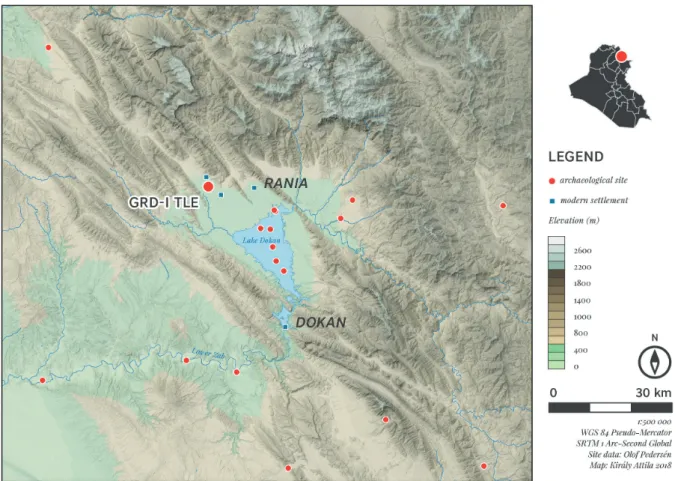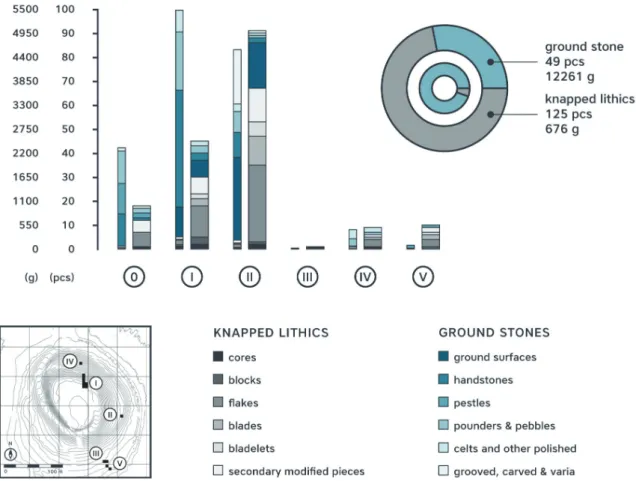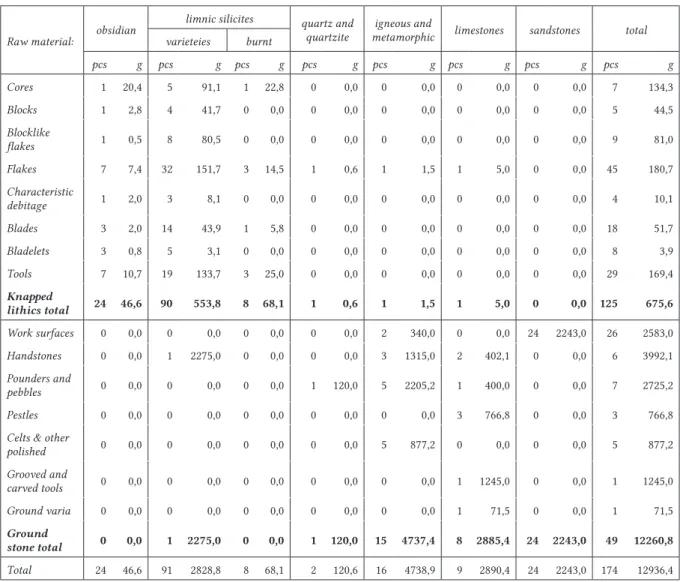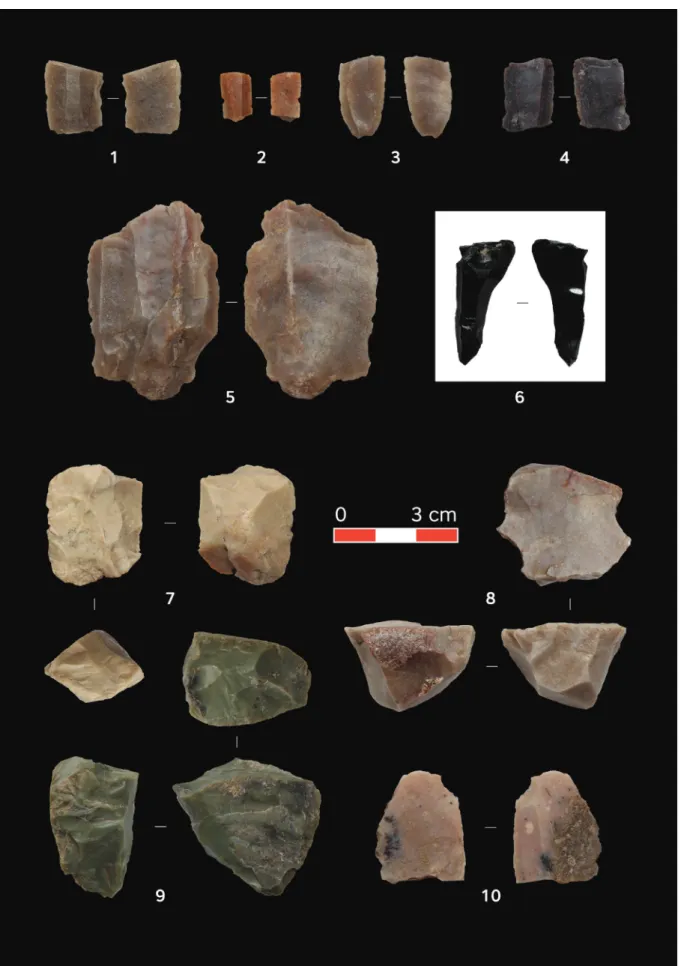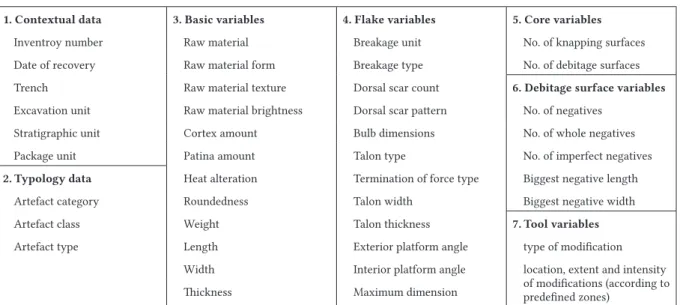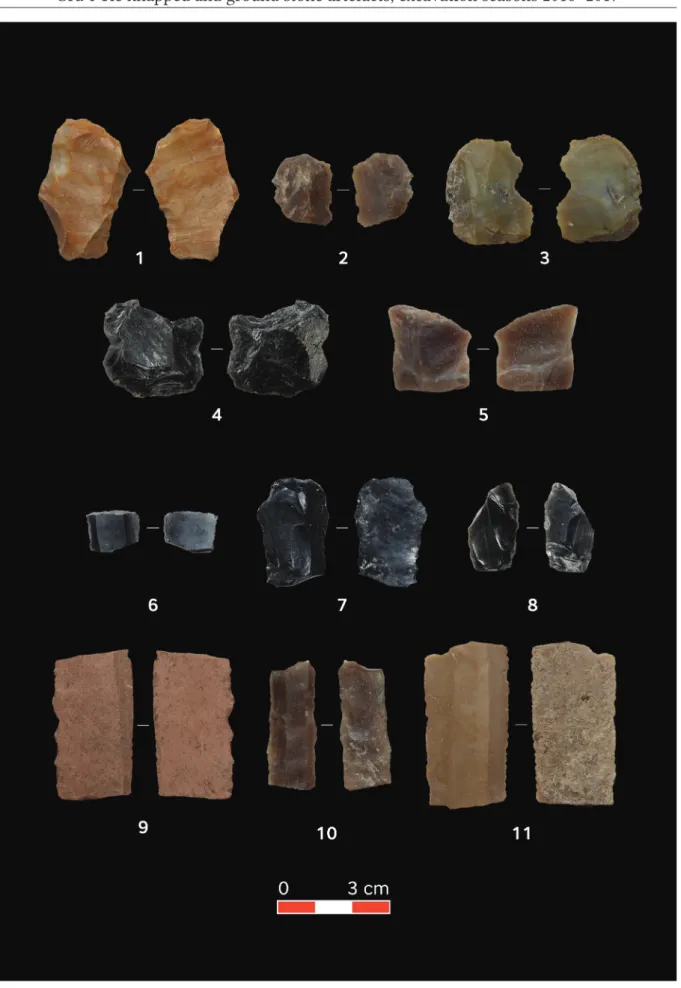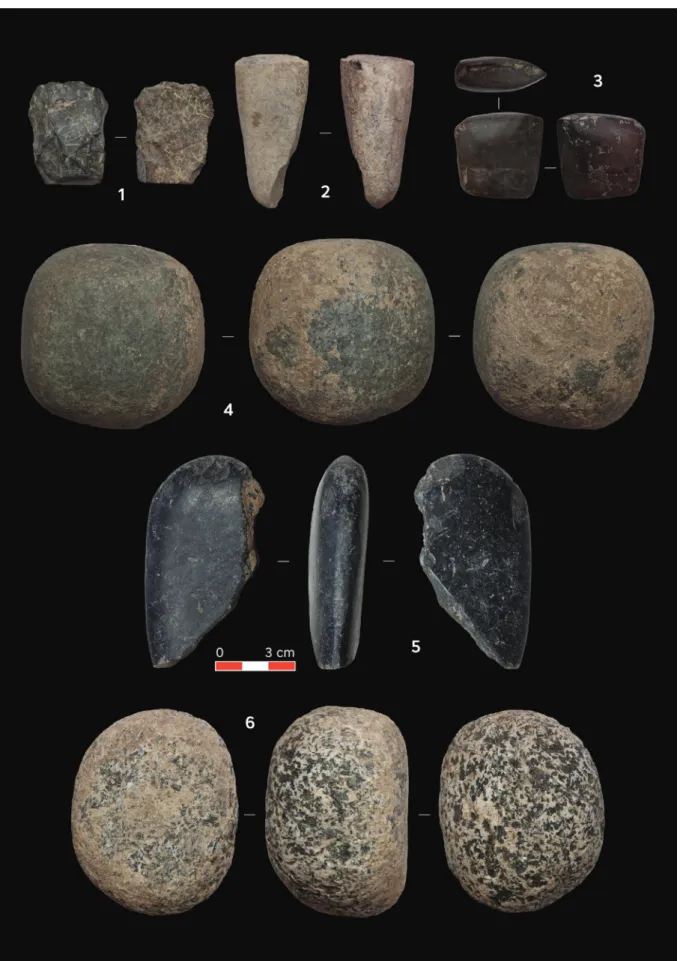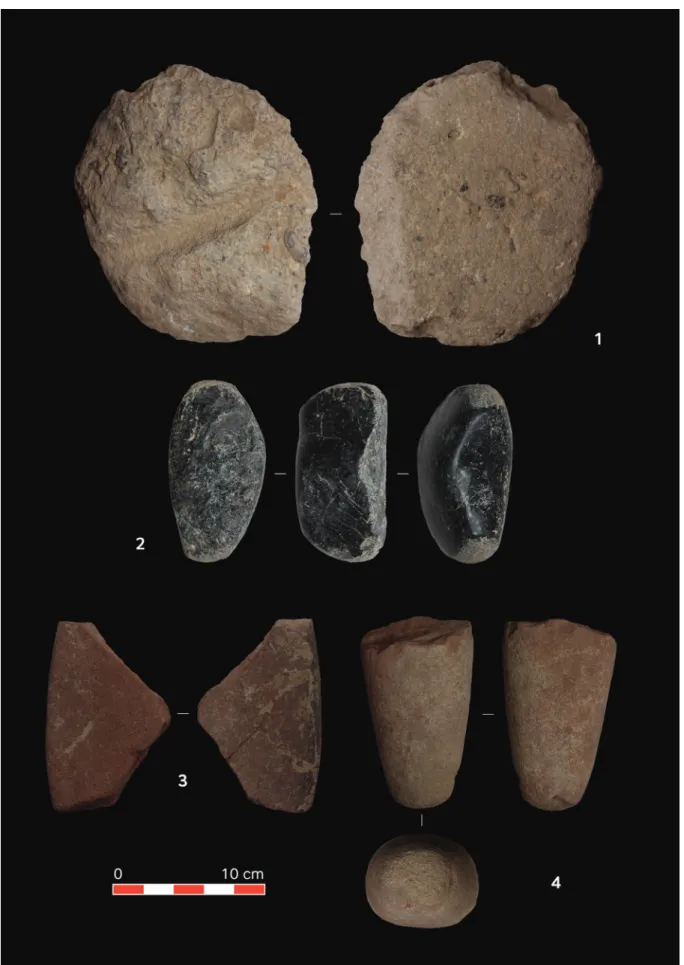Dissertationes Archaeologicae
ex Instituto Archaeologico
Universitatis de Rolando Eötvös nominatae Ser. 3. No. 5.
Budapest 2017
Dissertationes Archaeologicae ex Instituto Archaeologico Universitatis de Rolando Eötvös nominatae
Ser. 3. No. 5.
Editor-in-chief:
Dávid Bartus Editorial board:
László Bartosiewicz László Borhy Zoltán Czajlik
István Feld Gábor Kalla
Pál Raczky Miklós Szabó Tivadar Vida Technical editors:
Gábor Váczi Dávid Bartus
Proofreading:
Szilvia Szöllősi Zsófia Kondé
Available online at http://dissarch.elte.hu Contact: dissarch@btk.elte.hu
© Eötvös Loránd University, Institute of Archaeological Sciences
Budapest 2017
Contents
Articles
András Füzesi – Norbert Faragó – Pál Raczky 7
Tiszaug-Railway-station. An archaic Middle Neolithic community on the Great Hungarian Plain
Zsuzsanna Siklósi – Zsuzsanna M. Virág – Viktória Mozgai – Bernadett Bajnóczi 67 The spread of the products and technology of metallurgy in the Carpathian Basin
between 5000 and 3000 BC – Current questions
Attila Király 83
Grd-i Tle knapped and ground stone artefacts, excavation seasons 2016–2017
Tamás Dezső 97
The arrowheads from Grd-i Tle (Rania Plain, Iraqi Kurdistan)
Bence Soós 113
Early Iron Age burials from Tihany, Hungary
Abdullah Bakr Othman 207
The Middle Assyrian Ceramics at Sheikhi Choli Tomb
Katalin Vandlik 241
Le renard dans les fables antiques et ses représentations
Lajos Juhász 251
Burning money – a coin hoard from Brigetio
Bence Simon 259
Physical landscape and settlement pattern dynamics around Aquincum and Carnuntum – A socio-economic approach
Anna Herbst – Ágnes Kolláth – Gábor Tomka 287
Beneath the Marketplaces. Árpádian Age (10th–13th century) settlement traces from the city centres of Pápa and Győr, Western Hungary
Field Reports
Zoltán Czajlik – Saša Kovačević – Georg Tiefengraber et al. 343 Report on magnetometer geophysical surveys conducted in Hungary, Austria and Croatia in the framework of the Interreg Iron Age Danube project
Tamás Dezső – Gábor Kalla – Barzan Baiz Ismail et al. 361 Preliminary Report on the Hungarian Archaeological Mission (Eötvös Loránd University) at Grd-i Tle (Saruchawa) in Iraq. Second Season (2017)
Márton Szilágyi – Kristóf Fülöp – Eszter Rákos – Nóra Szabó 393 Rescue excavations in the vicinity of Cserkeszőlő (Jász-Nagykun-Szolnok county, Hungary) in 2017
Dóra Hegyi – Gergely Szoboszlay 401
Short report on the excavations in the Castle of Sátoraljaújhely in 2017
Thesis Abstracts
András Rajna 413
Changes in Copper Age Networks of Connections in Light of the Material Excavated in the Danube-Tisza Interfluve
Anikó Bózsa 423
Instruments of beauty care from the Hungarian part of Pannonia
Zsolt Körösfői 439
Die Marosszentanna-Kultur in Siebenbürgen
DissArch Ser. 3. No. 5. (2017) 83–96. DOI: 10.17204/dissarch.2017.83
Grd-i Tle knapped and ground stone artefacts, excavation seasons 2016–2017
Attila Király
Institute of Archaeological Science Eötvös Loránd University
attila@litikum.hu
Abstract
Knapped lithics and ground stone artefacts of the first and second excavation season at Grd-i Tle (Iraqi Kurdis- tan) derived from secondary contexts. We present these artefacts as assets to build an attribute-based metho- dology for recording and analysing lithics at the site, according to a life-history approach of material culture.
Grd-i Tle (Iraki Kurdisztán) lelőhely pattintott, csiszolt kőeszközei és szerszámkövei másodlagos helyzetben kerültek elő az ELTE régészeti expedíciójának első, illetve második ásatási évadja során. E tárgyak alkalmat kínáltak a kőanyag feldolgozási módszertanának kialakítására, amit az „anyagi kultúra élettörténete” elmé- leti megközelítés mentén végeztünk el. A leletek bemutatása mellett a továbblépés lehetőségeit tárgyaljuk a rövid jelentésben.
Introduction
The Eötvös Loránd University of Sciences archaeological expedition conducted excavations at Grd-i Tle, Iraqi Kurdistan during 2016 and 2017 (Fig. 1).1 According to our surveys this tell site has been occupied since at least the Late Neolithic period. So far, our expedition unearthed in situ Islamic and Hellenistic-Parthian remains, with an increasing number of lithic artefacts from different occupational periods, in secondary contexts.
Detailed documentation of these artefacts is justified by two factors. With our work we aimed to construct an archaeological reference site in the microregion, as this tell offers a 28-met- re thick stratigraphy. Encompassing lithic stray finds in our stratigraphic analyses helps to understand site formation processes. These finds also offer an opportunity to assess lithic variability across the ages represented, addressing methodological issues about their proper handling and interpretation in one single system of study.
Context, materials and methods
The collection consists of 125 knapped and 49 other modified lithic artefacts in 2017 (Tab. 1).
They were found as surface scatter (18 pieces) and as stray finds in stratigraphic units we in- vestigated during excavation, without sieving (156 pieces). Knapped lithics, as well as ground stone items were distributed unevenly among the excavated trenches with a strong bias towar- ds Trench II, especially if we take trench sizes into account (25 square meters against e.g.
1 Dezső et al. 2016.
84
Attila Király
Trench I with 175 square meters, Fig. 2). According to our preliminary observations, Trench II also contained a considerable amount of prehistoric ceramic sherds too. These distributional differences raise future research questions about the tell’s depositional history.
Our methodology for lithic analysis utilizes a life-history approach promoted by the French technological school’s chaîne opératoire and Michael Schiffer’s behavioral chain concepts.2 Artefacts are considered as focal objects collecting traces of interactions during their produc- tion, use and abandonment. In concert with this approach we recorded discrete attributes of these processes that are visible for the naked eye (Tab. 2).3 We did not have opportunities to conduct microscopic use-wear and residue analyses nor geochemical sourcing.
The investigation protocol included typological identification. For the knapped artefacts we adapted John Shea’s lists that synthetize standard classifications with age- and region-specific types.4 Our protocol allows researchers to use our data with their respective typologies as we recorded attributes in higher resolution than attribute-aggregate units, i.e. types. Definition of attributes, as well as basic data recorded are given in a separate supplement, as we pursue intelligent openness concerning data publication.5
2 Gosden – Marshall 1999; Hamon 2009; Knappett 2014; Miller 2007; Skibo – Schiffer 2008; Soressi – Geneste 2011.
3 Eitam 2009; Inizan et al. 1999; Shea 2013.
4 Shea 2013.
5 For intelligent opennes see Király 2017. As the database grows and criteria are prone to change, we depo- sited these data in the Figshare repository that has version control options. The actualized supplementary material is accessible through the DOI referred under Király 2018.
Fig. 1. Grd-i Tle and its environment in the Zagros High-Folded Zone, Iraqi Kurdistan (map: A. Király).
85 Grd-i Tle knapped and ground stone artefacts, excavation seasons 2016–2017
Polished stone tools, hammerstones and ground stone implements (together: ground stones) occur diverse contexts in almost every archaeological period in the region: as tools of food processing, pottery manufacture and metallurgy, as containers, items of social status or pa- raphernalia of ritual.6 Because of this variability, terminology, typology and research methods are manifold.7 The fundamental typology of prehistoric Near Eastern ground stone items is compiled by Katherine Wright with the help of Levantine collections.8 This typology provides guidelines for expeditions in Iraqi Kurdistan.9 To maintain uniform terminology we applied Wright’s system supplemented by the work of David Eitam, keeping in mind that: 1) our small collection now represents only a portion of the variability expected at Grd-i Tle; 2) currently we do not possess in situ contextual informations that can have an impact on classification;
3) the typology is based on Epipalaeolithic, Neolithic and Chalcolithic examples and has to be tested on artefacts of later ages.10
6 Adams 2008; Barkai 2011; Crandell et al. 2016; Delgado Raack – Risch 2008; Edwards 2007; Kadowaki 2006; Nadel 2011; Rosenberg – Nadel 2014.
7 Rosen 1997; Rosenberg et al. 2016; Rowan – Ebeling 2008.
8 Wright 1992; 2013.
9 E.g. Mudd 2017; Squitieri 2017.
10 Eitam 2009; Wright 1992; 2008.
Fig. 2. Grd-i Tle, spatial distribution of knapped lithics and ground stone items among excavation trenches (I–IV) and on the surface (0), according to artefact classes. Left coloumns represent we- ight data, right coloumns represent quantity. Inset map shows trench positions (data and graphics:
A. Király; map data: A. Weisz, Salisbury Ltd).
86
Attila Király
Raw material: obsidian limnic silicites quartz and
quartzite igneous and
metamorphic limestones sandstones total varieteies burnt
pcs g pcs g pcs g pcs g pcs g pcs g pcs g pcs g
Cores 1 20,4 5 91,1 1 22,8 0 0,0 0 0,0 0 0,0 0 0,0 7 134,3
Blocks 1 2,8 4 41,7 0 0,0 0 0,0 0 0,0 0 0,0 0 0,0 5 44,5
Blocklike
flakes 1 0,5 8 80,5 0 0,0 0 0,0 0 0,0 0 0,0 0 0,0 9 81,0
Flakes 7 7,4 32 151,7 3 14,5 1 0,6 1 1,5 1 5,0 0 0,0 45 180,7
Characteristic
debitage 1 2,0 3 8,1 0 0,0 0 0,0 0 0,0 0 0,0 0 0,0 4 10,1
Blades 3 2,0 14 43,9 1 5,8 0 0,0 0 0,0 0 0,0 0 0,0 18 51,7
Bladelets 3 0,8 5 3,1 0 0,0 0 0,0 0 0,0 0 0,0 0 0,0 8 3,9
Tools 7 10,7 19 133,7 3 25,0 0 0,0 0 0,0 0 0,0 0 0,0 29 169,4
Knapped
lithics total 24 46,6 90 553,8 8 68,1 1 0,6 1 1,5 1 5,0 0 0,0 125 675,6
Work surfaces 0 0,0 0 0,0 0 0,0 0 0,0 2 340,0 0 0,0 24 2243,0 26 2583,0
Handstones 0 0,0 1 2275,0 0 0,0 0 0,0 3 1315,0 2 402,1 0 0,0 6 3992,1
Pounders and
pebbles 0 0,0 0 0,0 0 0,0 1 120,0 5 2205,2 1 400,0 0 0,0 7 2725,2
Pestles 0 0,0 0 0,0 0 0,0 0 0,0 0 0,0 3 766,8 0 0,0 3 766,8
Celts & other
polished 0 0,0 0 0,0 0 0,0 0 0,0 5 877,2 0 0,0 0 0,0 5 877,2
Grooved and
carved tools 0 0,0 0 0,0 0 0,0 0 0,0 0 0,0 1 1245,0 0 0,0 1 1245,0
Ground varia 0 0,0 0 0,0 0 0,0 0 0,0 0 0,0 1 71,5 0 0,0 1 71,5
Ground
stone total 0 0,0 1 2275,0 0 0,0 1 120,0 15 4737,4 8 2885,4 24 2243,0 49 12260,8
Total 24 46,6 91 2828,8 8 68,1 2 120,6 16 4738,9 9 2890,4 24 2243,0 174 12936,4
Tab. 1. Knapped and groundstone artefact classes by raw material groups (Legend: pcs = pieces; g = grams. N = 174 pieces, all the retrieved knapped lithics and ground stone tools).
Raw materials
Grd-i Tle is situated on the fringe of the Rania Plain, along the upper reaches of River Lesser Zab, in the northwestern portion of the Zagros High-folded Zone.11 The mountains embracing this alluvial plain are mostly built up of Jurassic and Cretaceous carbonate rocks (e.g. lime- stone and dolomite) degraded into different clastic formations (e.g. marl and conglomerates), with cherts suitable for knapping.12 There are numerous cavities in the area – for example, the well-known Shanidar cave – where rich carstic water reservoirs formed.13 Fed by these reser- voirs, high-energy braided rivers transported considerable amount of sediments and clastics into the Rania Plain during Pleistocene times. These sediments, as well as contemporary ter- races of the Lesser and Greater Zab rivers, contained a variety of sedimentary, igneous and metamorphic rocks originated in the Zagros high folded, imbricate and suture zones.14 We found these locally available blocks, pebbles and cobbles as raw materials at the site (Tab. 1).
11 Jassim – Goff 2006; Sissakian – Fouad 2013. I thank Zsolt Veres (Hungarian Geological Protective Union) for the discussion of proper geological terms in Hungarian and English.
12 Ameen – Gharib 2014; Sissakian – Saeed 2012.
13 Stevanović et al. 2009.
14 Sissakian – Al-Jiburi 2014; Sissakian et al. 2016.
87 Grd-i Tle knapped and ground stone artefacts, excavation seasons 2016–2017
Fig. 3. Grd-i Tle, knapped lithics. 1–6, 10 – debitage products from regular blade production, 7–8 – exhausted single platform cores, 9 – exhausted narrow fronted blade core, 1–5, 7–10 – limnic silicite, 6 – obsidian (photos: A. Király).
88
Attila Király
1. Contextual data 3. Basic variables 4. Flake variables 5. Core variables
Inventroy number Raw material Breakage unit No. of knapping surfaces
Date of recovery Raw material form Breakage type No. of debitage surfaces
Trench Raw material texture Dorsal scar count 6. Debitage surface variables
Excavation unit Raw material brightness Dorsal scar pattern No. of negatives
Stratigraphic unit Cortex amount Bulb dimensions No. of whole negatives
Package unit Patina amount Talon type No. of imperfect negatives
2. Typology data Heat alteration Termination of force type Biggest negative length
Artefact category Roundedness Talon width Biggest negative width
Artefact class Weight Talon thickness 7. Tool variables
Artefact type Length Exterior platform angle type of modification
Width Interior platform angle location, extent and intensity
of modifications (according to predefined zones)
Thickness Maximum dimension
Tab. 2. Knapped lithics recorded attributes (variables).
Limnic silicite (chert) is the most common raw material among knapped lithics. We diffe- rentiated at least four varieties based on color, shine and texture. Obsidian is present as an exotic material with the nearest source in Southeastern Turkey.15 Ground stones have a wide raw material spectrum, that supposedly accords to the initial technomic function of the tools (i.e. abrading, cutting, polishing, pounding). Well delineated groups are rough-surface sand- stone plaquettes; smooth and polished blackish basalt or metamorphite objects. Coarse-grai- ned igneous rocks, limestones, quartz cobbles complement the picture – obsidian is not rep- resented in this artefact category.
Knapped lithics
The obviously mixed sample does not justify a coherent quantitative study. In the following two sections we offer qualitative description of the two artefact categories, knapped lithics and ground stone items.
Production
At least three production modes can be differentiated on the 125 knapped pieces. 32 out of 39 blades, bladelets and secondary modified pieces (tools) on supports of blade/let proportions show dorsal negatives in concord with the debitage axes of the pieces. These artefacts testify regular unipolar blade debitage (Fig. 3). Only one of the seven cores could exemplify this method: the artefact shape, the convexity, preparation and angle of the striking platform lend a narrow-fronted blade core appearance to this piece, characteristic for the Epipalaeolithic in the region (GDT3.000.3/0023, Fig. 3.9). Nevertheless, last detachments were conducted by bipolar-on-anvil technique leaving fractured, scaled and hinged scars on the knapped surface in opposite directions.
Mostly pebbles and cobbles had been transformed into cores (Fig. 3), they are retrieved in exhausted state: debitage surfaces are covered with irregular flake scars instead of blade ne-
15 Robin et al. 2016.
89 Grd-i Tle knapped and ground stone artefacts, excavation seasons 2016–2017
Fig. 4. Grd-i Tle, knapped lithics. 1 – reused retouched flake, 2, 5, 7: endscrapers; 6: retouched blade fragment; 8: retouched flake; 9–11: sickle blades. 1–3, 5, 9–11: limnic silicite; 4, 6–8: obsidian (photos: A. Király).
90
Attila Király
gatives, and their average length is only 29,7 millimeters, i.e. cores are small in comparsion with blades and flakes in the collection. Although average length of blades and bladelets are also around 30 millimeters, most of these artefacts are broken, representing only a portion of their original size. Two unipolar, one centripetal and four bipolar-on-anvil cores (including GDT3.000.3/0023) are complemented with blocks of lithics, also worked bipolar-on-anvil.
In our terminology, blocks do not have stigmata of flakes as bulb or talon and also lack stig- mata of core reduction such as differentiation between knapping and knapped surfaces, pat- terned removals – they are typically pieces shredded on anvil.
The three observed production modes are 1) regular blade debitage on single platform, pris- matic cores; 2) other unipolar, opposed and centripetal reduction methods; 3) application of bipolar-on-anvil technique on nearly exhausted cores and/or small pebble cores. Tested raw material blocks, fully cortical flakes and other initial stage elements are not represented in the sample yet. Advanced stages of manufacture are testified by blades and flakes including preparation elements. Exhausted cores and tools are seen as late stage artefacts. It is worth mentioning that advanced stage obsidian debitage is also present (e.g. GDT2.067.3/0037, Fig. 3.6; GDT5.353.3/0067, Fig. 4.4) as a cue for regional exchange of raw materials beyond tools, in nodule or core form.
As expected, tool type composition is eclectic (Fig. 4). Besides retouched blades (2), bladelets (2) and flakes (5), endscrapers (3) backed or truncated tools (3), notch and denticulé (2), sickle blades (3) and other modified pieces (3) are present. Most of the identified tool types were present in the region since the Epipalaeolithic period until the Early Bronze Age, strictly Palaeolithic types are missing.16
Use and post-depositional history
Microburin blow and other deliberate breaking techniques are observed among blades. These 30–50 millimetre-long pieces can be used as insets; two of them bear sickle sheen on one of their edges (GDT1.151.3/0050, Fig. 4.4; GDT2.400.3/0120, Fig. 4.10).17 Some retouched tools and at least six flakes and blades have more or less abraded edges considered as traces of intensi- ve use. Use retouch differs from post-depositional fragmentation by its localized and regular distribution along the edges of an artefact. Fragmentation and patination were also observed in the sample.
Ground stone items
Production
Ground stones of Grd-i Tle are forming three groups according to their intensity of modifi- cation. Sandstone plaquettes have only minimal shaping – delibarate partitioning of the mass through breakage (Fig. 6.3). A few hammerstones and pounding stones disfigured only by use wear, their ’production’ were limited to the selection of pebbles with appropriate shape. The second and third groups consist of objects with more intensive shape and surface modifica- tion. Examples of the second group are oval and rectilinear handstones (Fig. 5.4,6). Artefacts
16 Rosen 2012.
17 Rosen 1997, 49–50.
91 Grd-i Tle knapped and ground stone artefacts, excavation seasons 2016–2017
Fig. 5. Grd-i Tle, ground stone items. 1 – polished axe preform, metamorphite, 2 – small pestle (?), lime- stone, 3 – small axe, basalt, 4 – rectilinear handstone, metamorphite, 5 – polished stone plaquet (poun- der), basalt, 6 – oval handstone, granite (photos: A. Király).
92
Attila Király
with the highest modification intensity includes an unipolar cylindrical pestle (Fig. 6.4), polis- hed basalt pounders (Fig. 5.5, Fig. 6.2), and a miniature axe (Fig. 5.3). In the latter cases, shaping of the artefacts is difficult to determine as surface treatment obscures stigmata of previous production stages. Such an early stage usually is the determination of shape by knapping.18 A possible example for this stage is a thick flake of metamporphic rock with detachments shaping the whole mass of the piece, as well as inverse covering retouch along the distal part resembling an axe edge preform (Fig. 5.1).
Use and post-depositional history
Through macroscopic inspection we only can presume general uses of the artefacts. Shea del- ineates functional groups in accord with the raw material and shape (Fig. 5–6).19 Pulverizing equipments aim to process materials through friction: they are the above mentioned sand- stone working surfaces, handstones and pestles in our collection. Hammerstones for knapping do not always have an extensive working surface as with the case of handstones. Macroscopic traces of percussion are points of contact between the hammer and the passive object, but the- se traces can assemble an extended surface comparable to the working surfaces of pulverizing tools. The second functional group consist of polished celts and axes in Shea’s system. We also encounter here those artefacts that have an emphasis on polished surfaces, but the naked eye can not decide their exact function(s). The collection lacks examples of the next functional group, containers, and only have one instance of the perforated and incised objects’ group – a limestone block with smoothened base and a deep, straight groove on the upper surface. Some artefacts in the sample certainly surpass these categories as they demonstrate diverse shapes and more than one type and/or locale of usewear.
Patination is not remarkable but almost all the pieces have fracture surfaces. Breaks that ob- viously interrupt a silhouette formed with special care are considered as results of post-depo- sitional events (e.g. GDT2.067.4/0004, Fig. 5.4; GDT1.116.4/0040, Fig. 5.2). In other cases there are no clear indications when the break surfaces incorporated in the life history of an artefact (e.g. GDT0.000.4/0048, Fig. 6.2).
Discussion and conclusions
The 2016 and 2017 season provided us a heterogenous lithic collection from secondary cont- exts, well suited for the methodological groundwork to study this longstanding artefact ca- tegory at Grd-i Tle. Local raw material use is not unexpected with regard to the broad petrog- raphic spectrum of easily accessible rocks. The identified knapped stone production methods and tool types are common from the Neolithic to the Bronze Age. Deliberately broken blades and sickle blades display considerable formal variability that, in closed contexts, can indicate chronological or cultural differentiation. Other characteristic ‘markers’ e.g. backed bladelets, geometric microliths and points have to be found at the moment. Polished and ground stones represent vauge artefact classes and open contexts too.
Typological identification became a secondary avenue of research behind techno-economic considerations for various reasons. Typologies of Holocene Near Eastern lithics are over-
18 Rosenberg et al. 2016.
19 Shea 2013.
93 Grd-i Tle knapped and ground stone artefacts, excavation seasons 2016–2017
Fig. 6. Grd-i Tle, ground stone items. 1 – grooved limestone block, 2 – polished double pounder with specific shape, basalt, 3 – sandstone plaquette, 4 – unipolar cylindrical pestle, sandstone (photos: A. Király).
94
Attila Király
whelmingly based on Levantine and Northern Mesopotamian samples, we do not recognize publications that translate them into the Zagros region of Iraq.20 Moreover, the typological composition of these late industries are more restricted than for example Upper Palaeolithic ones, apart from a few very characteristic pieces like points. One of the reasons behind this could be the restricted time intervals for typological differentiation. Rosen explains a more prevalent cause, the changing role of lithic tools implemented in more complex socioeconom- ic systems, and of course into an enriched material culture:
“When examining lithic assemblages from complex societies in the Levant, factors such as craft specialization in both manufacture and use of chipped stone tools, a range of differing modes of distribution and exchange, and much regional, ethnic, and chronological variation render the idea of integrated assemblages almost useless.”21
We consider this reasoning valid for ground stones as well. Traditional typological com- parsions, (site-) inventory-based units and industries have an altered significance with the growing social complexity in the Zagros region during the lifetime of Grd-i Tle. Conse- quently our present methodology emphasizes technology and taphonomy over typology. In order to understand life histories of knapped lithics, apart from stigmata of production, we record the location and extent of modifications (e.g. retouch), use retouch and damage on the surface of the pieces, according to Clarkson’s zonal recording system.22 An unavoidable task for the future is to create a similar attribute-based formal study protocol of ground stones at the site.
We plan to grade up the resolution of these investigations with traceology/tribology to pur- sue the diverse tasks in which the artefacts – or different parts of the same artefact – took part. We also prepare a closer cooperation with other archaeological expeditions in the vi- cinity in order to explain access, distribution and use of lithic tools at a regional scale. In our opinion, knapped and ground stone tools offer a great potential in understanding everyday life and socioeconomic organization at Grd-i Tle and the region as well.
References
Adams, J. L. 2008: Beyond the Broken. In: Rowan, Y. M. – Ebeling, J. R. (eds.): New Approaches to Old Stones: Recent Studies of Ground Stone Artifacts. London, 213–229.
Ameen, F. A. – Gharib, H. 2014: Biostratigraphy of the Tethyan cretaceous successions from nort- hwestern Zagros fold–thrust belt, Kurdistan region, NE Iraq. Arabian Journal of Geosciences 7, 2689–2710.
Barkai, R. 2011: PPNA stone and flint axes as cultural markers: technological, functional and symbo- lic aspects. In: Healey, E. – Campbell, S. – Maeda, O. (eds.): The State of the Stone: Terminolo- gies, Continuities and Contexts in Near Eastern Lithics. Studies in Early Near Eastern Production, Subsistence, and Environment 13. Berlin, 443–448.
Clarkson, C. 2002: An Index of Invasiveness for the Measurement of Unifacial and Bifacial Retouch:
A Theoretical, Experimental and Archaeological Verification. Journal of Archaeological Science 29, 65–75.
Crandell, O. – Ionescu, C. – Mirea, P. 2016: Neolithic and Chalcolithic stone tools used in ceramics production: Examples from the south of Romania. Journal of Lithic Studies 3/1, 241–258.
20 For the terminology of regions see Rosen 2013.
21 Rosen 1997, 34.
22 Clarkson 2002.
95 Grd-i Tle knapped and ground stone artefacts, excavation seasons 2016–2017
Delgado Raack, S. – Risch, R. 2008: Lithic perspectives on metallurgy: an example from Copper and Bronze Age South-East Iberia. In: Longo, L. – Skakun, N. (eds.): Prehistoric Technology 40 years later: Functional Studies and the Russian Legacy. British Archaeological Reports – International Series 1783. Oxford, 235–252.
Dezső, T. – Kalla, G. – Mordovin, M. – Masek, Zs. – Szabó, N. – Baiz Ismail, B. – Rasheed, K. – Weisz, A. – Sándor, L. – Khwnsaw, A. – Amin, A. A. H. 2016: Preliminary Report of the Hun- garian Archaeological Mission of the Eötvös Loránd University to Grd-i Tle (Saruchawa) in Iraqi Kurdistan. Dissertationes Archaeologicae 3/4, 233–241.
Edwards, P. C. 2007: The context and production of incised Neolithic stones. Levant 39, 27–33.
Eitam, D. 2009: Late Epipalaeolithic Rock-Cut Installations and Groundstone Tools in the Southern Levant. Methodology and Classification System. Paléorient 35, 77–104.
Gosden, C. – Marshall, Y. 1999: The Cultural Biography of Objects. World Archaeology 31, 169–178.
Hamon, C. 2009: Lifecycle of a Neolithic quern: limits and contribution of a combined technical and functional analysis of grinding tools. In: Hamon, C. – Graefe, J. (eds.): New perspectives on querns in Neolithic societies. Bonn, 45–54.
Inizan, M.-L. – Reduron-Ballinger, M. – Roche, H. – Tixier, J. 1999: Technology and terminology of knapped stone. Nanterre.
Jassim, S. Z. – Goff, J. C. 2006: Geology of Iraq. Brno.
Kadowaki, S. 2006: Ground-Stone Tools and Implications for the Use of Space and Social Relations at‚
Ain Abu Nukhayla, a PPNB Settlement in Southern Jordan. In: Banning, E. B. – Chazan, M.
(eds.): Domesticating Space: Construction, Continuity and Cosmology in the Late Prehistoric Near East. Studies in Early Near Eastern Production, Subsistence and Environment 12. Berlin, 53–75.
Király, A. 2017: Kősivatag és adattenger: a digitális adatmegosztás hasznossága a régészeti kutatásban egy pattintott kő leletegyüttes kapcsán (Rocky desert and sea of data: advantages of digital data publication about knapped lithic artifacts in archaeology). Archaeologiai Értesitő 142, 217–237.
Király, A. 2018: Grd-i Tle lithic database. Figshare. https://doi.org/10.6084/m9.figshare.5830638.v1 Knappett, C. 2014: Materiality in Archaeological Theory. In: Smith, C. (ed.): Encyclopedia of Global
Archaeology. New York, 4700–4708.
Miller H. M.-L. 2007: Archaeological approaches to technology. Oxford.
Mudd, D. 2017: People and ground stone tools in the Zagros Neolithic - economic and social interpretations of the assemblage from Bestansur, Iraqi Kurdistan. Unpublished PhD thesis, University of Read- ing, Archaeology Department. URL: http://centaur.reading.ac.uk/71393/. Acquired: 05.01.2018.
Nadel, D. 2011: Stones in their symbolic context: Epipalaeolithic – Pre-Pottery Neolithic continuity in the Jordan Valley, In: Healey, E. – Campbell, S. – Maeda, O. (eds.): The State of the Stone:
Terminologies, Continuities and Contexts in Near Eastern Lithics. Studies in Early Near Eastern Production, Subsistence, and Environment 13. Berlin, 481–448.
Robin, A. K. – Mouralis, D. – Akköprü, E. et al. 2016: Identification and characterization of two new obsidian sub-sources in the Nemrut volcano (Eastern Anatolia, Turkey): The Sıcaksu and Kaya- cık obsidian. Journal of Archaeological Science: Reports 9, 705–717.
Rosen, S. A. 1997: Lithics after the Stone Age: a handbook of stone tools from the Levant. Walnut Creek.
Rosen, S. A. 2012: Lithic industries during the Holocene period. In: Potts, D. T. (ed.): A companion to the archaeology of the ancient Near East. Oxford, 237–260.
Rosen, S. A. 2013: Arrowheads, Axes, Ad Hoc, and Sickles: An Introduction to Aspects of Lithic Varia- bility across the Near East in the Bronze and Iron Ages. Lithic Technology 38/3, 141–149.
Rosenberg, D. – Nadel, D. 2014: The Sounds of Pounding: Boulder Mortars and Their Significance to Natufian Burial Customs. Current Anthropology 55, 784–812.
Rosenberg, D. – Rowan, Y. – Gluhak, T. 2016: Introduction. Leave no stone unturned: Perspectives on ground stone artefact research. Journal of Lithic Studies 3/3, 1–15.
Rowan, Y. M. – Ebeling, J. R. 2008: Introduction: The Potential of Ground Stone Studies. In:
Rowan, Y. M. – Ebeling, J. R. (eds.): New Approaches to Old Stones: Recent Studies of Ground Stone Artifacts. London, 1–15.
Shea, J. J. 2013: Stone tools in the Paleolithic and Neolithic near East: a guide. New York.
96
Attila Király
Sissakian, V. K. – Al-Jiburi, B. S. M. 2014: Stratigraphy of the High Folded Zone. Iraqi Bulletin of Geology and Mining Special Issue 6, 73–161.
Sissakian, V. K. – Al-Musawi, H. A. – Al-Ansari, N. – Knutsson, S. 2016: The Origin and Genesis of the Dokan Conglomerate, NE Iraq. Journal of Earth Sciences and Geotechnical Engineering 6/3, 1–15.
Sissakian, V. K. – Fouad, S. F. 2013: The Geology of Erbil and Mahabad Quadrangles, Scale 1:250.000, Sheets NJ-38-14 and NJ-38-15. Baghdad.
Sissakian, V. K. – Saeed, Z. B. 2012: Lithological map of Iraq, compiled using GIS techniques. Iraqi Bulletin of Geology and Mining 8(3), 1–13.
Skibo, J. M. – Schiffer, M. B. 2008: People and Things. A Behavioral Approach to Material Culture.
Dortrecht.
Soressi, M. – Geneste, J.-M. 2011: The History and Efficacy of the Chaîne Opératoire Approach to Lithic Analysis: Studying Techniques to Reveal Past Societies in an Evolutionary Perspective.
PaleoAnthropology 2011, 334–350.
Squitieri, A. 2017: Neo-Assyrian period small finds of Gird-i Bazar, 2016. In: Radner, K. – Kreppner, F. J. – Squitieri, A. (eds.): Unearthing the Dinka Settlement Complex. The 2016 Season at Gird-i Bazar and Qalat-i Dinka. Peshdar Plain Project Publications 2. Gladbeck, 155–168.
Stevanović, Z. – Iurkiewicz, A. – Maran, A. 2009: New insights into karst and caves of Northwest- ern Zagros, Northern Iraq. Acta Carsologica 38/1, 83–96.
Wright, K. I. 1992: A Classification System for Ground Stone Tools from the Prehistoric Levant.
Paléorient 18, 53–81.
Wright, K. I. 2008: Craft Production and the Organization of Ground Stone Technologies. In: Rowan, Y. M. – Ebeling, J. R. (eds.): New Approaches to Old Stones: Recent Studies of Ground Stone Arti- facts. London, 130–143.
Wright, K. I. 2013: The ground stone technologies of Çatalhöyük. In: Hodder, I. (ed.): Substantive Technologies at Çatalhöyük: Reports from the 2000–2008 Seasons. London, 365–416.
